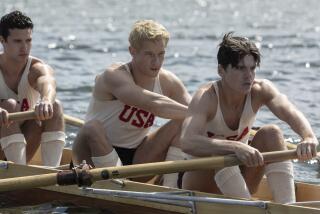AMERICA’S CUP 1987 : Sketches of Stars & Stripes Crew, as Seen in a Manager’s Perspective
- Share via
FREMANTLE, Australia — As crew manager for Stars & Stripes, Jon Wright had to know more about the people on it than what was in their sailing resumes.
“Compatibility and attitude are the key things,” he says. “Attitude first. With a two-year program, you don’t want anybody with a bad attitude.”
Wright has his own personal sketches of the crew.
Scott Vogel, bowman: “Low key, never gets excited. Probably the best bowman in the business. Excellent balance. Has more experience in 12-meters than anybody else out here.”
John Barnitt, mastman: “Extremely dedicated to the effort. Tall, strong, good balance. The quiet type, but not as quiet as Scotty.”
Jay Brown, pitman: “A real perfectionist. It’s funny, because when I first interviewed Jay I didn’t know how he was gonna fit into the program. He hadn’t had a lot of big boat experience, but the thing that struck me was what a sincere person he was. I figured we’d find a spot for him.”
Jim Kavle, port grinder: “He’s my neighbor at home in Rosemont, Pa. A big, burly guy that did a lot of ocean racing, and we were looking for extra strength this time. We felt he might fit in as a grinder on the ‘A’ team, and he’s lived up to our expectations.”
Kyle Smith, starboard grinder: “A lot of experience from two other campaigns. Great sense of humor. Knows when to be light and when to be serious on the boat. If there’s tension he can lighten things up. He’s good for Dennis.”
Henry Childers, starboard grinder: “Henry is probably the strongest guy we have. Very bright guy. He balances out with Henry. You don’t have to be smart and weak. You can be smart and strong.”
Adam Ostenfeld, starboard tailer: “Has the most ocean racing experience of anybody on the boat. He’s done more races with more people all over the world than anybody in the whole sport that I know of. A really talented guy. Flew helicopters in Vietnam.”
Bill Trenkle, port tailer: “He’s a professional. He and Scotty put the whole thing together for Dennis. Quick hands for shifting the sheets on and off the drum. A good eye for sail shape. An artist and an athlete combined into one. You get an override, you can lose the race. We haven’t had any since the October trials.”
Tom Whidden, tactician: “He and Dennis work together so well . . . they trust each other. The secret to our success.”
Peter Isler, navigator: “A secondary tactician and navigator. Navigation is not as big a deal as it was in Newport because the course is shorter. You can see where you’re going. But your relative position on the course is important.
“What Peter brings to us is a new, young aggressive style of sailing--the new stuff--and a great knowledge of the rules, a real student of tactics. That’s good, because Dennis and Tom could stay stale by doing certain tactical situations the way they were always done. Peter brings in some fresh ideas.
“Peter does all the measuring of the two boats (on the race course). Tom does all the chatter, like, ‘You’re higher, faster, lower, slower. Wind’s going left, wind’s going right.’ So Dennis can just concentrate on the speedo and steer the boat, and I can hear all the input so we don’t have to look around.”


